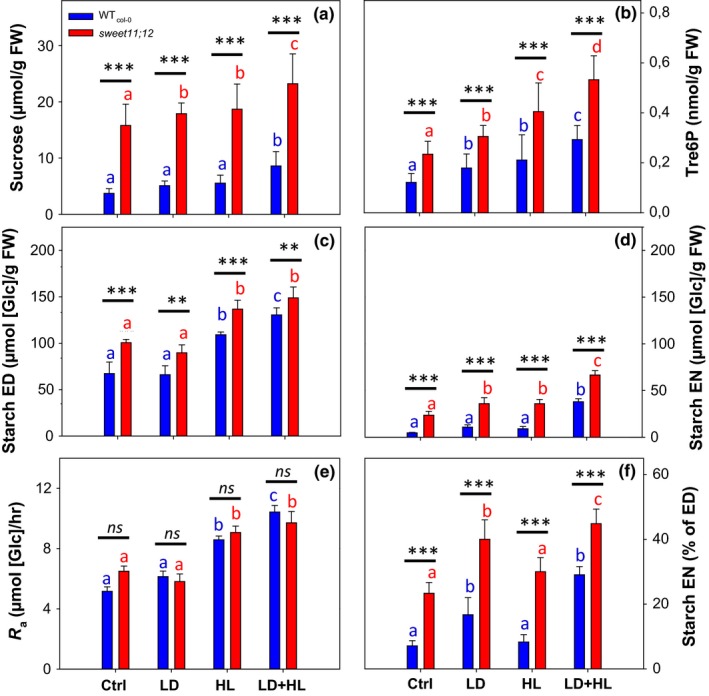Figure 2.

Effect of short‐term treatments to alter dusk starch content on night‐time levels of Tre6P and sucrose, starch content at dusk and dawn and starch mobilization in wild‐type Col‐0 and the sweet11;12 mutant. Wild‐type Col‐0 plants (WT) and sweet11;12 double mutants were grown in standard conditions (12‐hr/12‐hr light/dark cycle, 21°C, 160 μmol m−2 s−1 PFD). Three weeks after germination, batches of plants were left in standard conditions (Ctrl) or were shifted for a single day either to a long‐day condition (LD, 15‐hr photoperiod, 21°C, 160 μmol m−2 s−1 PFD), or to high‐light condition (HL, 12‐hr photoperiod, 21°C, 320 μmol m−2 s−1 PFD), or a combined LD and high‐light condition (LD + HL). Samples were collected at the end of the light period (ED) after the shift, and throughout the following dark period at 3‐hr intervals, up to the end of the night (EN) for metabolite analysis. (a) Night‐time sucrose and (b) night‐time Tre6P levels, averaged from ZT15 to ZT24, see Supporting Information Figure S3 for values at each time; (c) starch content at ED; (d) starch content at EN; (e) absolute rate of starch mobilization (R a), estimated from the slope of the linear regression of starch contents measured along the night from dusk to dawn (see Figure 3); (f) starch content at EN expressed as a percentage of starch content at ED. Values are mean ± SD (n = 5). Asterisks indicate statistically significant genotype‐dependent differences in a given treatment: *p < 0.05, **p < 0.01, and ***p < 0.001. Letters indicate significant treatment‐dependent differences in a given genotype; blue letters indicate treatment differences within WTC ol‐0, and red letters indicate differences within sweet11;12 double mutant (one‐way ANOVA, Holm‐Sidak post hoc pairwise multiple comparison testing, p < 0.01). The original data are provided in Supporting Information Table S2, and the temporal changes of Tre6P, sucrose, and other selected metabolites are shown in Supporting Information Figure S2. A replicate experiment for the Crtl, LD, and HL treatments is shown in Supporting Information Figures S3 and S4. ZT, zeitgeber time (hours after dawn)
